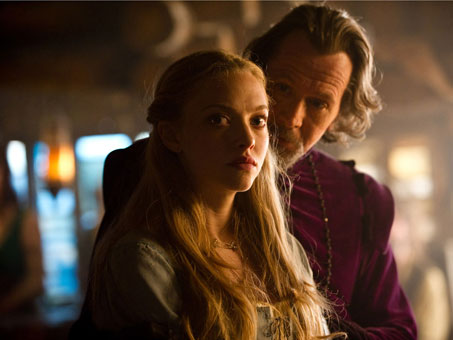While my first instinct is to avoid analyzing a trailer to uncover the potential validity of the new Amanda Seyfried reincarnation of Red Riding Hood, something holds me back from my charge toward complete obloquy, though it’s tricky given that the film is being marketed to audiences by noting it is “From the director of Twilight,” and while Catherine Hardwicke did a decent job writing and directing Thirteen, Twilight is a harbinger of terrible mishmashes of mythology and silliness that barely obscures the pedestrian love triangle in the middle by throwing in gimmicky elements like vegetarian vampires and sparkly epidermises. However, the something that stymies the visceral reaction I have to Meyer’s brainchild is Gary Oldman, and his ability to create a believable character that carries a film – even if it should by all means move at a slug’s pace. Similarly, Seyfried is a conundrum. She was funnily endearing as an uber-ditzy blonde in Mean Girls, entertaining in Mama Mia, but seemingly lost in Chloe and Jennifer’s Body. However, she’s shown a lot of range, so we’re at least working with two believable, perhaps even suitable, characters here.
Then, we have the plot point driving the film: Valerie’s (Seyfried) arranged marriage to Henry (Max Irons), a wealthy, blondish looking fellow, which impedes her love for Peter (Shiloh Fernandez), an orphaned woodcutter who is clearly not at affluent as Henry. This trope is overdone, but let’s ponder for a moment the possibility that Red Riding Hood is actually an intelligent allegory about xenophobia, which could be gleaned given the exotic aesthetic of Peter, a brown hair, brown eyed, brooding individual who has entered the village and disrupted tradition. In addition, Valerie’s plan to run away with Peter coincides with her older sister being murdered by a werewolf who has reneged on his end of a bargain to avoid killing village members in exchange for a monthly sacrifice.
We could jump the gun here and prophecy that the murderer is probably Valerie’s father or maybe even someone related to Henry with the intention of placing the blame on anyone associated with Peter – and we’d probably be accurate – but when Father Solomon (Oldman) arrives in the village, the presence of the werewolf offers a potential social commentary on paranoia and the pejorative “outsider.” Strolling through the assembled villagers, Solomon exposits, “in the daytime, the werewolf returns to his human form. The real killer lives here in this village; it could be your neighbor; your homes will be searched; your secrets brought to light,” which recalls various facets and addendums to the Patriot Act enacted by the United States Government after 2001. In other words, a violent, inexplicable act – like a werewolf breaking a tenuous truce – begs for a resolution, particularly when the identity of the werewolf is unknown.

Unlike a number of bogeymen and other creatures and things that go bump in the night, the werewolf is a shapeshifter, an animal form covering a true identity. Regardless of the horrors committed by the beast, the man underneath is protected by his violent alter ego. That said, the inability to point a finger at the absolute cause of violence begets paranoia, encouraging distrust amongst fellow villagers, and making them hyperaware of any incident that could illuminate the wolf’s identity. In the same vein, the unknown also casts a pall of suspicion over everyone, thus the illegal search and seizure of property is justified for “the good of the village,” disregarding any notions of privacy. While everyone is treated as equal suspects, evidence brought to light not pertaining to the discovery of the werewolf could damage families for generations by exhibiting the skeletons in everyone’s closets.
Thus, Solomon’s quest for the wolf also fashions Red Riding Hood into a narrative about the quest for purity – the elimination of the tainted “outsider” and the preservation of the well-bred, loyal members of the village – those who are arranged to marry and be married, those with snow white skin and blonde hair like Valerie and Henry. Peter, the brooding outsider, and his brethren will be the first suspected and the hardest pushed, creating arteries and causeways to condemn and snuff out other outsiders.
And while it’s hard to overlook the shaky, yet speedy, hand-cam quest through the woods that supposedly mimics the hunting werewolf like the Nothing in The Neverending Story, it’s important to note how Nine Inch Nail’s “The Hand that Feeds” plays over all released versions of this trailer, and how it’s a song that speaks about betrayal and a “crusade […] justified in the name of the holy and divine,” illustrating yet another form of “outsider” – the religious “other,” a pagan, a blood-drinker, a cult-member, a heretic, a Protestant.
It seems less coincidental than intentional that Father Solomon is Catholic and beset by numerous gold crucifixes, including the carriage from which he exits, adorned with crosses and religious symbols, including the crucifix-shaped window in his door.
Red Riding Hood has the potential to run the gamut of social issues, poking holes in the contradictions of government benevolence, privacy during wartime, xenophobia, and prejudice, but it could very well be restricted by its connection to Twilight, which will more than likely pull in droves of Twi-hards and slightly-post pubescent teen girls, and if this is the producers’ intentions – considering the marketing and tag lines – then they have wasted a fine allegory and have rejected the courage to employ the timeless teaching tools of fairy tales.






